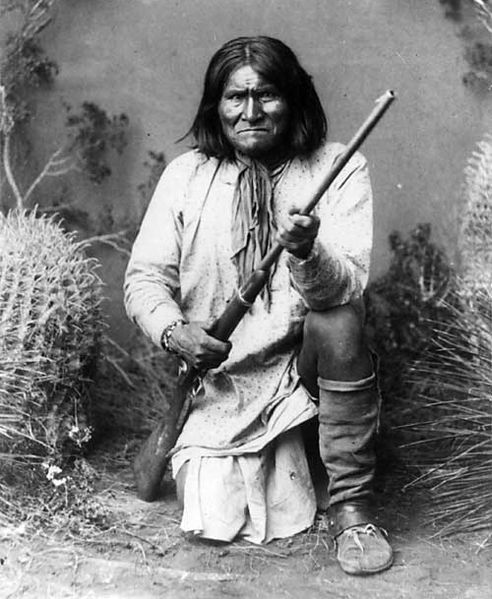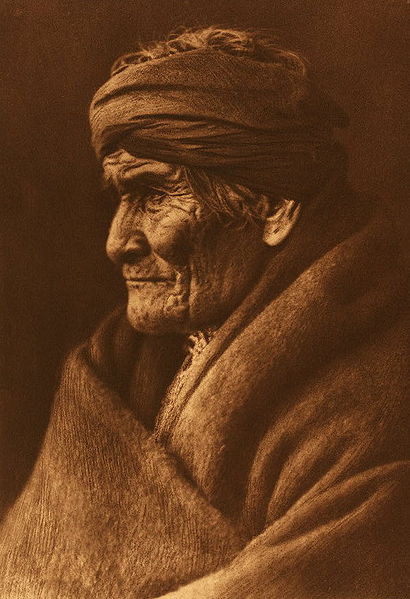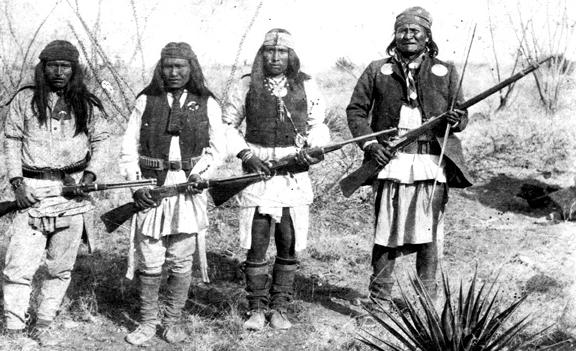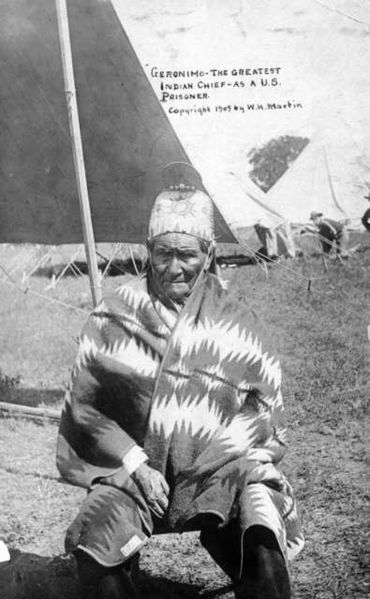<Back to Index>
- Cytogeneticist Barbara McClintock, 1902
- Actor and Director Arthur Stanley Jefferson (Stan Laurel), 1890
- Apache Leader and Warrior Geronimo, 1829



Geronimo (Chiricahua: Goyaałé, "one who yawns"; often spelled Goyathlay or Goyahkla in English) (June 16, 1829 – February 17, 1909) was a prominent Native American leader and medicine man of the Chiricahua Apache who fought against Mexico and the United States and their expansion into Apache tribal lands for several decades during the Apache Wars.
Goyahkla (Geronimo) was born to the Bedonkohe band of the Apache, near Turkey Creek, a tributary of the Gila River in the modern-day state of New Mexico, then part of Mexico, but which his family considered Bedonkohe land. His grandfather (Mako) had been chief of the Bedonkohe Apache. He had three brothers and four sisters. Geronimo's parents raised him according to Apache traditions; after the death of his father, his mother took him to live with the Chihenne (red paint people) and he grew up with them. He married a woman (Alope) from the Nedni-Chiricahua band of Apache when he was 17; they had four children. On March 6, 1858, a company of 400 Mexican soldiers from Sonora led by Colonel José María Carrasco attacked Geronimo's camp outside Janos while the men were in town trading. Among those killed were Geronimo's wife, his children, and his mother. His chief, Mangas Coloradas, sent him to Cochise's band for help in revenge against the Mexicans. It was the Mexicans who named him Geronimo. This appellation stemmed from a battle in which, ignoring a deadly hail of bullets, he repeatedly attacked Mexican soldiers with a knife, causing them to utter appeals to Saint Jerome ("Jeronimo!"). The name stuck.
The first Apache raids on Sonora and Chihuahua appear to have taken place during the late 17th century. To counter the early Apache raids on Spanish settlements, presidios were established at Janos (1685) in Chihuahua and at Fronteras (1690) in northern Opata country. In 1835, Mexico had placed a bounty on Apache scalps. Two years later Mangas Coloradas or Dasoda-hae (Red Sleeves) became principal chief and war leader and began a series of retaliatory raids against the Mexicans. Apache raids on Mexican villages were so numerous and brutal that no area was safe.
While Geronimo said he was never a chief, he was a military leader. As a Chiricahua Apache, this meant he was one of many people with special spiritual insights and abilities known to Apache people as "Power". Among these were the ability to walk without leaving tracks; the abilities now known as telekinesis and telepathy; and the ability to survive gunshot (rifle/musket, pistol, and shotgun). Geronimo was wounded numerous times by both bullets and buckshot, but survived. Apache men chose to follow him of their own free will, and offered first-hand eye-witness testimony regarding his many "powers". They declared that this was the main reason why so many chose to follow him (he was favored by/protected by "Usen", the Apache high-god). Geronimo's "powers" were considered to be so great that he personally painted the faces of the warriors who followed him to reflect their protective effect. During his career as a war chief, Geronimo was notorious for consistently urging raids and war upon Mexican Provinces and their various towns, and later against American locations across Arizona, New Mexico, and western Texas.
He married Chee-hash-kish and had two children, Chappo and Dohn-say. Then he took another wife, Nana-tha-thtith, with whom he had one child. He later had a wife named Zi-yeh at the same time as another wife, She-gha, one named Shtsha-she and later a wife named Ih-tedda. Some of his wives were captured, such as the young Ih-tedda. Wives came and went, overlapping each other, being captured and added to the family, lost, or even given up, as Geronimo did with Ih-tedda when he and his band surrendered. At that time he kept his wife She-gha but abandoned the younger wife, Ih-tedda. Geronimo's last wife was Azul.
Though
outnumbered, Geronimo fought against both Mexican and United States
troops and became famous for his daring exploits and numerous escapes
from capture from 1858 to 1886. One such escape, as legend has it, took
place in the Robledo Mountains of
southwest New Mexico. The legend states Geronimo and his followers
entered a cave, and the U.S. soldiers waited outside the cave entrance
for him, but he never came out. Later it was heard that Geronimo was
spotted in a nearby area. The second entrance to the cave has yet to be
found and the cave is still called Geronimo's Cave. At the end of his
military career, he led a small band of 36 men, women, and children.
They evaded thousands of Mexican and American troops for over a year,
making him the most famous Native American of the time and earning him
the title of the "worst Indian who ever lived" among white settlers. His
band was one of the last major forces of independent Native American
warriors who refused to acknowledge the United States occupation of the American West. In 1886, General Nelson A. Miles selected Captain Henry Lawton, in command of B Troop, 4th Cavalry, at Ft. Huachuca and First Lieutenant Charles B. Gatewood to lead the expedition that captured Geronimo. Numerous
stories abound as to who actually captured Geronimo, or to whom he
surrendered, although most contemporary accounts, and Geronimo's own
later statements, give most of the credit for negotiating the surrender
to Lt. Gatewood. For Lawton's part, he was given orders to head up
actions south of the U.S.–Mexico boundary where it was thought Geronimo
and a small band of his followers would take refuge from U.S.
authorities. Lawton was to pursue, subdue, and return Geronimo to the U.S., dead or alive. Lawton's
official report dated September 9, 1886 sums up the actions of his unit
and gives credit to a number of his troopers for their efforts.
Geronimo gave Gatewood credit for his decision to surrender as Gatewood
was well known to Geronimo, spoke some Apache, and was familiar with
and honored their traditions and values. He acknowledged Lawton's
tenacity for wearing the Apaches down with constant pursuit. Geronimo
and his followers had little or no time to rest or stay in one place.
Completely worn out, the little band of Apaches returned to the U.S.
with Lawton and officially surrendered to General Miles on September 4,
1886 at Skeleton Canyon, Arizona. When Geronimo surrendered he had in his possession a Winchester Model 1876 lever-action rifle with a silver-washed barrel and receiver, bearing Serial Number 109450. It is on display at the United States Military Acadamy, West Point, New York. Additionally he had a Colt Single Action Army revolver with a nickel finish and ivory stocks bearing the serial number 89524 and a Sheffield Bowie knife with
a dagger type of blade and stag handle made by George Wostenholm in an
elaborate silver-studded holster and cartridge belt. The revolver, rig,
and knife are on display at the Fort Sill museum. The
debate still remains whether Geronimo surrendered unconditionally.
Geronimo pleaded in his memoirs that his people who surrendered had
been misled: his surrender as a war prisoner was conditioned in front
of uncontested witnesses (especially General Stanley.) General Howard,
chief of Pacific US army division, said on his part that his surrender
was accepted as a dangerous outlaw without condition, which has been
contested in front of the Senate. Geronimo and other Apaches, including the Apache scouts who had helped the army track him down, were sent as prisoners to Fort Pickens, in Pensacola Florida, and his family was sent to Fort Marion. They were reunited in May 1887, when they were transferred to Mount Vernon Barracks in Alabama for seven years. In 1894, they were moved to Fort Sill, Oklahoma. In his old age, Geronimo became a celebrity. He appeared at fairs, including the 1904 World's Fair in St. Louis,
where he reportedly rode a ferris wheel and sold souvenirs and
photographs of himself. However, he was not allowed to return to the
land of his birth. He rode in President Theodore Roosevelt's 1905 inaugural parade. In 1905, Geronimo agreed to tell his story to S.M. Barrett, Superintendent of Education in Lawton, Oklahoma.
Barrett had to appeal to President Roosevelt to gain permission to
publish the book. Geronimo came to each interview knowing exactly what
he wanted to say. He refused to answer questions or alter his
narrative. Barrett did not seem to take many liberties with Geronimo's
story as translated by Asa Daklugie. Frederick Turner re-edited this
autobiography by removing some of Barrett's footnotes and writing an
introduction for the non-Apache readers. Turner notes the book is in
the style of an Apache reciting part of his oral history. In
February, 1909, Geronimo was thrown from his horse while riding home,
and had to lie in the cold all night before a friend found him
extremely ill. He died of pneumonia on February 17, 1909 as a prisoner of the United States at Fort Sill, Oklahoma. On his deathbed, he confessed to his nephew that he regretted his decision to surrender. He was buried at Fort Sill in the Apache Indian Prisoner of War Cemetery. Geronimo
was raised with the traditional religious views of the Bedonkohe. When
questioned about his views on life after death, he wrote in his 1905
autobiography, "As to the future state, the teachings of our tribe were
not specific, that is, we had no definite idea of our relations and
surroundings in after life. We believed that there is a life after this
one, but no one ever told me as to what part of man lived after
death ... We held that the discharge of one's duty would make his
future life more pleasant, but whether that future life was worse than
this life or better, we did not know, and no one was able to tell us.
We hoped that in the future life, family and tribal relations would be
resumed. In a way we believed this, but we did not know it." Later in life, Geronimo embraced Christianity,
and stated, "Since my life as a prisoner has begun I have heard the
teachings of the white man's religion, and in many respects believe it
to be better than the religion of my fathers ... Believing that in
a wise way it is good to go to church, and that associating with
Christians would improve my character, I have adopted the Christian
religion. I believe that the church has helped me much during the short
time I have been a member. I am not ashamed to be a Christian, and I am
glad to know that the President of the United States is a Christian,
for without the help of the Almighty I do not think he could rightly
judge in ruling so many people. I have advised all of my people who are
not Christians, to study that religion, because it seems to me the best
religion in enabling one to live right." He joined the Dutch Reformed Church in 1903 but four years later was expelled for gambling. To
the end of his life, he seemed to harbor ambivalent religious feelings,
telling the Christian missionaries at a summer camp meeting in 1908
that he wanted to start over, while at the same time telling his
tribesmen that he held to the old Apache religion. Six members of the Yale secret society of Skull and Bones, including Prescott Bush, served as Army volunteers at Fort Sill during World War I.
It has been claimed by various parties that they stole Geronimo's
skull, some bones, and other items, including Geronimo's prized silver bridle, from the Apache Indian Prisoner of War Cemetery at Fort Sill, Oklahoma. Alexandra Robbins says this is one of the more plausible items said to be in the organization's Tomb. In
1986, former San Carlos Apache Chairman Ned Anderson received an
anonymous letter with a photograph and a copy of a log book claiming
that Skull & Bones held the skull. He met with Skull & Bones
officials about the rumor; the group's attorney, Endicott P. Davidson,
denied that the group held the skull, and said that the 1918 ledger
saying otherwise was a hoax. The group offered Anderson a glass case with a skull of a ten-year-old boy, but Anderson refused it. In 2006, Marc Wortman discovered a 1918 letter from Skull & Bones member Winter Mead to F. Trubee Davison that claimed the theft: The second "tomb" references is the building of Yale University's Skull and Bones society. But Mead was not at Fort Sill, and Cameron University history professor David H. Miller notes that Geronimo's grave was unmarked at the time. The revelation led Harlyn Geronimo of Mescalero, New Mexico, to write to President Bush requesting his help in returning the remains: In 2009, Ramsey Clark filed a lawsuit on behalf of people claiming to be Geronimo's descendants, against, among others, Barack Obama, Robert Gates, and Skull and Bones, asking for the return of Geronimo's bones. An article in The New York Times states that Clark "acknowledged he had no hard proof that the story was true." Investigators ranging from Cecil Adams to Kitty Kelley have
rejected the story. A Fort Sill spokesman told Adams, "There is no
evidence to indicate the bones are anywhere but in the grave site." Jeff Houser, chairman of the Fort Sill Apache tribe of Oklahoma, calls the story a hoax.

